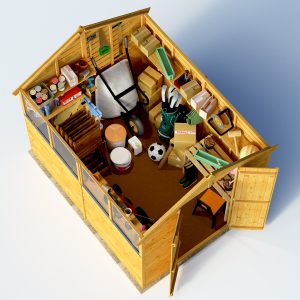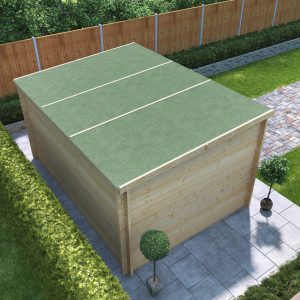Jump to:
Hold up, ‘when did spring start?’ we hear you asking.
Spring 2022 started on March 20th, so by now, it’s well underway. Still, a lot of us are guilty of not quite getting around to any spring cleaning yet.
It’s all too easy for sheds to become a bit of a dumping ground, especially after winter. And, while we’re always on the lookout for steps to help spring clean the garden, our sheds often get overlooked.
But if you’re reading this article, then it means that you’ve got the intention to start. And here at Garden Buildings Direct, we’re going to help you along every step of the way.
First, we’ll run through a quick checklist for our spring cleaning and maintenance guide, then we can get to work!
Checklist for spring cleaning and maintaining your shed. You’ll need:
- Some space cleared outside your shed
- A broom (and a brush and dustpan)
- Bin bags
- Microfibre cloths
- A pressure washer or garden hose
- (Optional) Drill, screws, hooks, shelving, and storage bins
Step-by-step guide for spring cleaning and maintaining your shed:
- Take everything out of your shed
- Clean the interior (sweep, mop up spills, and dust)
- Pressure wash the outside of your shed (using a garden hose for shed windows)
- Install shelves, hooks, and storage boxes
- Organise tools and put them back inside your shed
- (Optional) Re-paint your shed and install a lock
Now that we’ve got an outline for spring cleaning and shed maintenance, let’s dive in!

Spring Clean Your Shed Inside
There’s no point asking ‘how to clean a wooden shed’ if we don’t talk about the inside. Don’t worry, we’ve all got skeletons in our closet when it comes to shed maintenance. However, if you follow these steps you won’t have to revisit this guide every spring!
Step 1 – Take everything out of your shed
This first step is what we here at GBD like to call ‘The Full Monty’ – because you get everything out!
Ok, cheesy jokes aside – if you want a clean storage shed for spring 2021, you need to start here. Wait for a good run of weather on the day or weekend you’ve set aside and start by moving everything outside.
Once you’ve got a good idea of what’s in your shed versus how much room you have, you’ll be on to a winner.
Step 2 – Clean up
And of course, now that everything’s out of your garden building, you can start with cleaning up what’s left in it.
Whether you’ve got a small shed or a large shed, we suggest you run through these steps for cleaning outdoor buildings:
- Get rid of cobwebs. Use a duster or microfibre cloth to remove loose dirt, dust, and cobwebs. Don’t forget to check shed corners and lintels.
- Clean up spills. Whether it’s oil or cleaning product spills, take the time to clean it up. Spills often happen in those hard-to-reach places and are easy to fob off until next time. But today is that next time!
- Sweep the floor. Start from the corners and sweep out all that dust and dirt. This is also a great opportunity to check for any floor hazards in your tool shed. Keep an eye out for loose floorboards or exposed nails.
- Future-proof your shed. Think about all the little bits of shed maintenance that you don’t want to leave for another year. Lay rodent traps if your shed is being affected by little critters. Don’t leave it until it’s too late and you have to call a shed cleaning service!
Then, once you’ve got the inside looking empty and clean, let’s step outside for a moment. We like to get everything clean on the outside at this point, but feel free to jump ahead.
Spring Clean Your Shed Outside
Before you get into organising the inside of your shed or garden room, let’s have a look at the outside. Spring cleaning your shed is one of your best chances to reevaluate its exterior as well.
Plus, you can check whether there are any pesky leaks or gaps in your shed’s cladding and roof. This will help you with the next two steps on our checklist.

Step 3 – Check Your Shed’s Roof
Something that we get asked all the time is about spring cleaning and maintenance tips for a shed roof. Well, look no further.
If you’ve damp-proofed your shed roof then check if it has excess debris on it and use this time to clear it. If your shed has moss growing on it, use moss killer to remove it.
Although you may think moss provides a shed roof with a layer of protection, it’ll just hold moisture.
By following this step, you’ll help to prevent water from pooling on your shed roof and roof felt. In turn, this can halt structural damage to your shed’s roof. You might even decide that you want to install a shed guttering system at this point.
Once you’ve done that, you can move on to:
Step 4 – Washing Your Shed’s Exterior
It’s all very well and good spring cleaning a shed on the inside, but what about the outside?
An outdoor building can be much more than a storage shed, it can be a point of pride in your garden. So roll your sleeves up and wash your shed in two stages.
First, pressure wash your shed to blast away old debris and even chipped paint. However, make sure to stay away from the windows!
Use a garden hose with a spray nozzle or even a wet cloth to clean your shed windows separately. This way you won’t break any.
At this point, while your glorious new shed is drying in the sun, you may decide you want to re-treat the wood.
If so, nip down to your local garden centre and pick up some wood stain and maybe even some paint. A good quality wood preserver will ensure the longevity of even cheap garden sheds.
These spring maintenance steps will help bring the outside of your shed back to life. Then you can move on to the final stages of organising the inside of your shed.

Organise Your Shed Inside
You may have skipped ahead to this part of our spring cleaning shed guide after clearing your shed out. If so, feel free to go back to the last section about cleaning your shed’s exterior.
If you’ve been with us for the whole ride, let’s crack on with our top tips for organisation and maintenance.
Step 5.1 – Install shelves, hooks, and storage boxes
We’d hazard a bet that one of the reasons you’re reading this guide is because of troubles with organisation. And hey, who can blame you?
Lucky for you, we’ve come up with some quick fixes. So read on to get your garden buildings future-proofed all the way till next spring.
- Install shelves. Storage shelves will mean spending a bit of cash on your shed if you don’t already have them. But the dividends are well worth it! Adding shelves can help you maximise on space and keep garden tools grouped together.
You could even construct shelving from leftover plywood or pallets for a budget alternative.
- Use storage bins. Now that you’ve got shelving under your belt (and above your head!) you can move onto storage bins. Bins are great for organising items that can’t be hung or easily stacked. Make sure to label them to ensure you and family members put items back in the right spot.
- Put up hooks. If you’re not utilising your garden shed’s walls then you’re missing out. The great thing about garden tools is that a lot of them were designed to be hung up. Think about how much space you could save by having a couple of hooks to hold garden spades, shovels, and forks!
So, is your shed looking spick and span? If so, now it’s time for the second part of our penultimate step.
Step 5.2 – Put everything back inside your shed
Your storage shed can be used for storage once again!
Take everything from those neat piles outside your shed and repopulate the inside. Make sure to put them away on the appropriate shelving or in the right bin to get into good habits.
You can even think about keeping garden tools you’ll be needing over the spring and summer closer to the front. Think about prioritising things like lawnmowers and strimmers. These are tools that are going to see a lot of use soon. Then you can keep items like holiday decorations at the back of your tool shed.
Use this opportunity to think about items you want to get rid of – either sell or donate them. With all that done, you’ll be ready to move on to the final touches.
Spring Cleaning Your Shed: Final Touches
Phew! Well done for making it all the way to the end of our garden spring cleaning and maintenance guide for sheds. Give yourself a pat on the back.
Hopefully, your garden will be clear again of all your tools. And those same tools will be neatly stacked, shelved, and hung in your garden shed. So whether you’ve got a cosy little storage shed or a full-blown outdoor workshop, you’ll be able to use your space again.
At this point, we’d recommend some final touches like adding a lock to your shed if you haven’t already. This is important for keeping people out and away from your tools. And, it helps to keep children away from dangerous machinery.
You could always think about marking tools as well if you’re worried about theft. This will also depend on whether you’re planning on reselling them. You can either use a simple marker pen or security labels and tags with your information on them.
Once you’ve done all that you should have a shed that’s clean and tidy and ready to use again. Remember – utilise those storage bins and hooks in your outdoor building. Then you won’t have to read this guide again next spring!
And if you really want to plan ahead, check out our guide about how to look after your shed during winter.
FAQs
How to clean a wooden shed
Hopefully, this guide to spring cleaning and maintenance tips for your shed has helped answer that question. We’d say follow these steps for success:
- Take everything out of your shed
- Clean the interior (sweep, mop up spills, and dust)
- Pressure wash the outside of your shed (using a garden hose for shed windows)
- Install shelves, hooks, and storage boxes
- Organise tools and put them back inside your shed
- (Optional) Re-paint your shed and install a lock
Shed cleaning services
You could always hire someone to clean your shed for you - but where’s the fun in that? We think that with a day or two with some clear weather and a pair of helping hands, you can have your shed spick and span again.
How to clean the outside of a shed
Start by pressure washing slats and cladding, making sure not to soak the roof or hit glass windows. Debris and moss should be removed from your roof to allow for proper drainage.
How to remove mildew from a shed
You can purchase simple mould and mildew removers from most garden stores. Alternatively, mix around 3/4 cup bleach into a bucket full of water for a DIY solution.
How to clean a shed floor
First things first, take everything out so that you can access the whole floor. The spaces under lawnmowers and shelves often go unnoticed.
Then, start by sweeping out your shed. Once you’ve done this, you can address any liquid spills.
Should I pressure wash the outside of my shed?
Yes, if you can. But be careful to avoid the roof and windows. If not, a garden hose with a spray nozzle or even a cloth and a bucket of water works just as well.
How do I keep wildlife out of my shed?
Laying things like rodent traps will help to keep pests away. If you have vents in your shed you should always make sure to cover them in a wire mesh. Also, try to keep your shed securely locked when not in use.
If you’d like to learn more about how to keep wildlife out of your shed, check out this guide.





